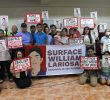By CJ KUIZON | Davao Today
In North Cotabato, fourteen year old Zaida remembers how government soldiers burn down their house, destroying many of their possessions in the fire. “Even the Q’uran,” recalls Zaida, �And my birth certificate.�
In Surigao del Sur, thirteen year old Risa saw the wounds and bruises on her father and uncle. “I got sick after seeing my father’s and my uncle’s wounds,� she recalls. �My younger sister also became sick because of it.”
She said the two men were stopped at a military checkpoint. When the military saw their motorcycle laden with food, the two were tied up, beaten and made to walk back several kilometers to their home on their bare feet. They were also forced to eat uncooked eggplants.
Also in Surigao del Sur, Nina, 19, recalls how, when she was still in school, government soldiers rounded up the female students. One of the soldiers said, “The girls here are beautiful, I feel like kissing them on the lips.”
These are just a few of the stories featured in the book ‘Uncounted Lives: Children, Women, and Conflict in the Philippines,’ the culmination of years of research made by Philippine research think-tank Ibon Foundation.
Funded by the United Nations children’s fund (Unicef), the Ibon book delves into the lives of women and children living in areas under the influence of the New People’s Army (NPA) and the Moro Islamic Liberation Front (MILF), hence, the subject of the Armed Forces of the Philippines (AFP) operations.
The 350-page book, recently launched in Davao city, covers eight communities where on-going armed encounters between government troops and either the NPA or the MILF rebels occurred; namely: Abra and Mindoro Oriental in Luzon; Capiz and Leyte in the Visayas; and Surigao del Sur, Compostela Valley, North Cotabato and Maguindanao in Mindanao.
All eight communities commonly acknowledged to have known the presence of either the NPA or the MILF as far back as the 1970s and where, during the 2001 to 2005 period covered by the study, armed confrontations intensified.
Ibon documented a total of 195 armed confrontations in these eight communities, resulting to the death of 50 civilians.
Researchers led by Ibon spent at least two weeks in each area and applied a scientific approach to the very personal stories of the women and children.
In her review of the book, Dr. Herminia Ugay, Ph. D., the director of the Little Lambs Shool of Davao, said that reading the stories will make people feel the pain, hunger, fear, and uncertainty that those caught in the web of conflict experience.
Aside from the direct physical harm to children, armed conflict and the consequent violence and drastic change in routine and environment to families and communities results in psychosocial trauma. These vary from nervousness, sleeplessness, absent-mindedness and lack of appetite to recurring nightmares, depressions, mood swings to attempted suicide and more severe stress related illnesses and symptoms.
Ishak, a Moro from North Cotabato, was 12 years old when an explosion threw him in the air as his family was fleeing their village. Upon reaching the evacuation center, he acquired a high fever and had convulsions. Since then, for several years now, he has succumbed to occasional fits of epileptic seizures.
Tonina, 14, of Maguindanao whose younger brother was killed in one of the encounters between the AFP and the MILF, expressed open hostility against the soldiers. “I want them all to die in the next war, if there is one, I want all those soldiers to be finished off and killed,” she said.
Chabeng, in his early teens, of Capiz said he wanted to join the NPA when he grew up because he wanted to get even with government soldiers and to help the poor.
As a reactor during the book launching, Ugay observed that members of the community seemed to be more comfortable with the rebel groups. She said that it was food for thought that women and children in the communities felt “more victimized by the military than by the rebels.”










